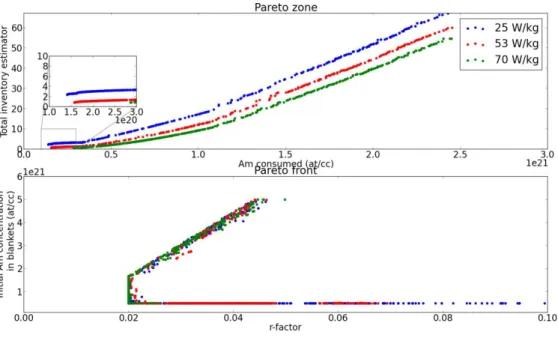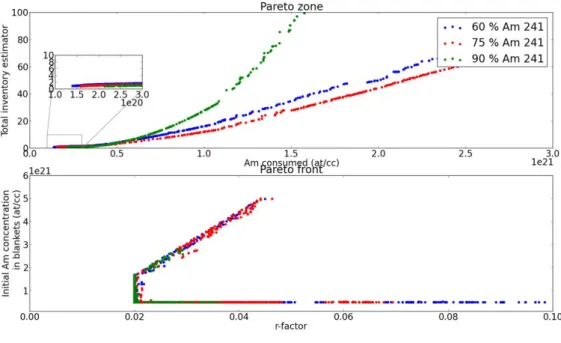HAL Id: cea-02388825
https://hal-cea.archives-ouvertes.fr/cea-02388825
Submitted on 2 Dec 2019
HAL is a multi-disciplinary open access
archive for the deposit and dissemination of sci-entific research documents, whether they are pub-lished or not. The documents may come from teaching and research institutions in France or abroad, or from public or private research centers.
L’archive ouverte pluridisciplinaire HAL, est destinée au dépôt et à la diffusion de documents scientifiques de niveau recherche, publiés ou non, émanant des établissements d’enseignement et de recherche français ou étrangers, des laboratoires publics ou privés.
Optimization of minor actinides bearing radial blankets
for heterogeneous transmutation in fast reactors
Timothee Kooyman, Laurent Buiron, G. Rimpault
To cite this version:
Timothee Kooyman, Laurent Buiron, G. Rimpault. Optimization of minor actinides bearing radial blankets for heterogeneous transmutation in fast reactors. Nuclear Science and Engineering, Academic Press, 2017, 185 (2), pp.335-350. �10.1080/00295639.2016.1272381�. �cea-02388825�
Optimization of minor actinides bearing radial blankets for heterogeneous transmutation in fast reactors
Abstract:
A new methodology dedicated to the optimization of minor actinides (MA) transmutation in dedicated blankets is discussed here. In the so-called heterogeneous transmutation approach, minor actinides are loaded in specific assemblies located at the periphery of a fast reactor core. Thus, the resulting perturbation on the core behavior is limited and the management of minor actinides is entirely decoupled from standard fuel management. This also allows greater flexibility in the blankets design, in terms of material, volume fraction or neutron spectrum to be used. On the other hand, the low neutron flux level experienced at the periphery of the core slows down the transmutation process. If this effect can be compensated by an increase of the minor actinides fraction loaded in the blankets, this also strongly increases their decay heat and neutron source level, which complicates spent fuel reprocessing and handling.
An optimization is carried out with regards to the neutron spectrum and americium concentration in the blankets, with the dual objective of maximizing the transmuted MA mass while minimizing the total MA inventory in the fuel cycle by limiting the cooling time of such blankets. Artificial neuron networks are coupled with a genetic algorithm in order to reduce total calculations time. It is shown here that regardless of the MA mass to be loaded, the use of a slightly moderated neutron spectrum is the most promising option for heterogeneous transmutation. This result is confirmed by full core calculations. An analysis with regards to the irradiation time is also performed, and it is shown that maximization of the irradiation time should be sought in the specific case studied here. It is concluded that from a purely physical point of view, no breakthrough can be obtained for heterogeneous transmutation.
1. Introduction:
Minor actinides transmutation is a potential solution which is currently investigated for long-term management of nuclear waste. In the case of a closed plutonium fuel cycle, minor actinides are the main responsible for long-term radiotoxicity and short-term decay heat of the nuclear waste package. In the transmutation process, neptunium, americium and eventually curium, which are the three main minor actinides produced in nuclear reactors, are submitted to a neutron flux in order to turn them into shorter-lived fission products by fission or successive captures followed by fissions. This way, radiotoxicity levels can be lowered up to a factor 200 in the best case [1] and a reduction of a factor 3 of the final repository footprint can be achieved [2].
Various options have been proposed so far for minor actinides transmutation, including thermal reactors [3], ADS [4] and fast reactors [5]. We will focus here on the fast reactor option as targeted by French R&D programs. Two approaches have been discussed for transmutation in fast reactors, namely the homogeneous one and the heterogeneous one. A complete comparison of these two options can be found in [6] and a small breakdown of the most salient points for each case is done below.
In the homogeneous approach, minor actinides are directly mixed in the fuel in quantities above the “natural” fraction of minor actinides in the fuel (e.g. 1 %vol to 3 %vol). This approach has been developed for instance in the IFR [7] [8] in the US. It exhibits the advantage of having relatively good transmutation performances as the minor actinides to be transmuted are directly located in a high-flux zone, thus speeding up the transmutation process. It can be carried out without separating plutonium from minor actinides, thus lowering the associated proliferation risks. However, it leads to a “pollution” of the entire fuel cycle with minor actinides, which have negative impacts on every step of the fuel cycle [2] due to the increase in thermal activity and neutron source of the spent fuel. Additionally, this approach leads to potential “safety” issues for reactor operations, as high minor actinides fractions in the fuel have a negative impact on coolant void worth and Doppler feedback and thus lower the “safety” margins of the core [9] [10] compared to MA-free fuel. These can be prevented by either decreasing the power density in the core [11], which decreases the efficiency of the core, or by modifying the core layout [12].
In the heterogeneous approach, minor actinides are loaded in dedicated assemblies, usually located at the core periphery but MA can also be incorporated in some selected driver assemblies [13]. In this case, the “driver” fuel cycle and the “transmutation” fuel cycle are completely separated and impacts on core operations are limited as the minor actinides are located in low flux level zones. However, this has the drawback of decreasing the transmutation performances, which can be compensated by increasing both the loaded mass and the residence time of the assemblies. These adaptations of targets irradiation configuration consequently lead to thermo-mechanical issues in the design of the blankets, which must to withstand increased helium release from alpha decay of some isotopes, such as 242Cm, and potentially high swelling leading to fuel-cladding mechanical interaction. Furthermore, this has a strong impact on targets decay heat and neutron source, which increases the safety requirements for handling and transportation at the manufacturing, transportation and reprocessing steps [2].
We will focus here on the heterogeneous approach – more specifically the case where MA are loaded in blankets at the periphery of the core – and on its impacts on the fuel cycle. The expected fuel cycle for minor actinides bearing blankets (MABB) is described below in Figure 1. The spent fuel (both drivers and blankets assemblies) is stored until it has reached an acceptable decay heat and activity level and then reprocessed. The separated minor actinides are then recovered and re-used for target manufacturing while the plutonium is re-used for driver production. Fission products and eventually curium, depending on the scenario considered, are sent to ultimate waste (glass packages here), along with the losses during the reprocessing step. In this case, we considered only americium transmutation in the blankets, as this case is conservative in terms of irradiated blankets decay heat and neutron source and removes constraints on the manufacturing step due to high curium activity compared to americium.
Figure 1 : Heterogeneous minor actinides transmutation fuel cycle
As it can be seen in Table 1, main fuel cycle parameters such as decay heat at specific times or neutron source levels are increased compared to a regular fuel assembly. The enhanced decay heat at short time scale will have an impact on handling of the target assemblies during refueling outages ,if it is not carried out under sodium, while the long term decay heat will require longer cooling time to reach acceptable values for manufacturing and reprocessing. High neutron source leads to a radioprotection hazard which will complicate every step of the fuel cycle from manufacturing to transportation.
Table 1 : Selected fuel cycle parameters for driver and target assemblies of a homogeneous SFR [14] with 20 % Am in the blankets for 4100 EFPD
Driver Target
Target with ZrH2
Decay heat at 30 days (kW/assembly) 17 51 58
Decay heat at 5 years (kW/assembly) 1 10 12
Neutron source at 30 days (1e3 n/s/assembly) 2.1 31.5 36.6
Neutron source at 5 years (1e3n/s/assembly) 1.3 20.3 23.8
The increase in short term decay heat comes from the production of 242Cm from 241Am transmutation while the increase is long term decay heat is due to 244Cm from 243Am transmutation and of 238Pu from the decay of 242Cm and 242Am. The neutron source increase is also due to the production of 244Cm and heavier Curium isotopes. We will focus here on the impacts on decay heat. Data on the main contributors to long-term decay heat is given below in Table 2.
Table 2: Main contributors to long-term decay heat of spent fuel
Isotope 242Cm 244Cm 238Pu 241Am Power density (W/g) 121.4 2.84 0.57 0.11
Half life (year) 0.44 18.1 87.2 432
According to [15] and considering the availability of storage drum technology, the current limitations for assembly handling outside of the reactor vessel are due to the manipulation under sodium from
the vessel to external in-sodium storage, currently limited at 20 kW per assembly which is expected to rise up to 40 kW in the future [2], and the washing of the assembly. Current limitations for washing an assembly and removing it from internal storage are set at 2.5 kW and are expected to rise up to 7.5 kW. We considered here that once a sub-assembly has been washed, it can be reprocessed and its heavy nuclide content reused for manufacturing within two years. If an equilibrium between production in the core and consumption of minor actinides in the blankets has been achieved, the total inventory in the fuel cycle can be approximated by multiplying the mass in the blankets by the ratio of the cooling time over the irradiation time. This is done in Figure 2. It can be seen that loading more americium in the blankets may both increase the performances but also the cooling time required to reach a given limit.
Figure 2 : Evolution of the total inventory in cycle vs loaded mass for a constant limit for reprocessing set at 7.5 kW per assembly. Calculations were made using the core design available in [16].
In the past, implementation of heterogeneous transmutation using moderated blankets has been proposed (see [17] for instance, and more recently [18]). The objective of this approach is to take advantage of both the high flux level in fast reactors and the high absorption cross sections in the epithermal range compared to the fast range to speed up the transmutation process. However, this exhibits the drawback of increasing the production of curium and thus the target decay heat and may also increase the total americium inventory in the cycle in the case of multi-recycling. Additionally, the use of hydride as moderating material may be a concern in terms of safety due to potential hydrogen dissociation during accidental transients [19].
We consider here an equilibrium situation for americium production and consumption in the whole fuel cycle, where the entire production of americium in the core is matched by consumption in minor actinides bearing blankets when considering an irradiation step followed by five years of cooling. That is to say, the consumption in the blankets is equal to the production in the core plus the production in the cooling fuel during 5 years. Curium is discarded as a waste during the reprocessing step. Such a situation is for instance discussed in [19].
In the present case, the efficiency of the total transmutation process can be characterized by: - The efficiency of americium destruction process during irradiation, which is a measure of the
number of reactor units equipped with blankets necessary to transmute a given amount of americium.
- The total inventory of americium in the fuel cycle in order to limit the nuclear material mass flow in the fuel cycle.
Both parameters depend on the neutron spectrum and the initial MA mass loaded in the blankets. Considering these specificities of the transmutation process, the use of a generic optimization process is discussed here. The optimization is carried out using the two parameters mentioned above and the objectives described in the previous paragraph. Constraints on the fuel cycle are also considered here using the reference data described before. Such a process is described in the first part of this paper. It is applied in a second part, while in the last part, a comparison with full core calculations is made.
2. Characterization of the heterogeneous approach for minor actinides
transmutation
a. Algorithm used
This work is based on the results from [20] which show that transmutation performances of a fast neutron system can be roughly characterized by two parameters: the amount of minor actinides loaded in the system and the typical neutron spectrum in the blankets. The r-factor, defined in Equation 1 was used here to parametrize and quantifies the neutron spectrum properties. The americium vector used contained 75 % of 241Am and 25% of 243Am. The objective of this part is to build simplified yet accurate-enough meta-models of the heterogeneous transmutation process which does not require complete core description and depletion calculations, in order to be able to carry a general optimization process in a reasonable time scale.
The following approach was implemented:
a first set of cell calculations for a fixed core configuration with 40 % oxide fuel, 40 % coolant and 20 % 56Fe as structures material was carried out, with 22.1 % of plutonium in the fuel. These volume fractions are a good approximation of actual volume fraction in a fast reactor. Then, these spectrums and flux levels were used for source-based calculations of a blanket medium with a variable composition in terms of fuel, coolant and moderating material in order to cover as wide as possible a spectrum range. The data used for this approach are given below in Table 3. The cell calculations were carried out using the ECCO cell code [21].
Table 3 : Variation range of used parameters for cell calculations
Fuel type Oxide, Nitride, Carbide, Metal (10
%vol Zr)
Coolant type Helium, Sodium, Lead-Bismuth
Eutectic
Moderating material variation
range 0-10 %vol
Americium volume fraction
variation range 5-40 %vol
The minor actinides bearing blankets are depleted for 4000 EFPD using a constant flux approximation and the DARWIN code system [22]. In the case of heterogeneous transmutation, this approximation is deemed realistic enough as blankets are exposed to a constant flux level from the core. A flux level of 6 1014 n/cm2/s was used, which corresponds to the level of flux achievable with a 3600 MWth SFR. One thousand calculations were run to obtain a learning base for the construction of artificial neuron networks which are trained to evaluate the transmutation rate and both the neutron source and decay heat at various time steps (5,10,20,50 and 100 years). This was done using the URANIE platform developed by CEA [23].
Using the computed values for decay heat and neutron source, the evolution of these quantities was approximated by a logarithmic law , starting from five years cooling time which is the minimum cooling time considered here. The a and b parameters were fitted for each case using scipy and a least-square method [24].
Table 4 : Evaluation of some meta-modelling discrepancies. The cases annotated (Ann) correspond to artificial neuron networks calculations and the cases annotated (Reg) correspond to logarithmic regression of the decay heat.
Transmutation rate Decay heat after 5 years cooling (Ann) Decay heat after 20 years cooling (Ann) Decay heat after 5 years cooling (Reg) Decay heat after 20 years cooling (Reg) Mean error (%) 0,22 -0,19 -0,24 -4,18 3,25 Standard deviation (%) 4,09 3,01 2,38 2,13 2,15
An evaluation of some meta-modelling errors is given in Table 4. It can be seen that the mean discrepancy of the artificial neuron networks is close to zero, with standards deviations below 4 % in all cases. This corresponds to average errors of 1 %p in the transmutation rate value and around 5 W/kg for decay heat calculations, the mean value after five years cooling being 258 W/kg.. The use of logarithmic regression to fit the decay of a mix of radio nuclides leads to small systematic bias in the calculations.
It also of interest to observe, as it can be seen in Figure 3, that most of the dispersion of the meta-models can be found in extremal regions of the problem, either with a low r factor corresponding to the use of zirconium hydride, or in the high- r-factor domain corresponding to high loading of minor actinides. However, it can be seen that the mean error between 0.05 and 0.20 for r is close to zero and that this domain corresponds to “realistic” approaches with limited amount of minor actinides in the blankets.
Figure 3 : Repartition of the meta-modelling discrepancies on the transmutation rate with regards to the r factor considered
A genetic algorithm was used to evaluate the Pareto-optimal cases, e.g. the cases for which it is not possible to achieve a gain in one objective without a loss in another one. Each case was characterized using a (r,Am) tuple, with r the r-factor of the spectrum and Am the americium concentration in the target in at/cc. The r-factor is defined as the difference in lethargy between a neutron emission and neutron absorption in Equation 1. up and ud designate respectively the average
production and removal by absorption or leakage lethargy of the neutron.
(1)
Two objectives were considered here for the optimization and were in this case minimized: - I, which is an estimator of the total inventory of americium in cycle
- C, which is an estimator of the transmuted americium mass
I and C expressions with regards to the various parameters are given below in Equations 2 and 3, with T being the total irradiation time and the maximal allowable decay heat for assembly washing and transportation after five years cooling. A minimal cooling of five years was considered. Rate is defined as the transmutation rate of americium, e.g. the fraction of americium having been consumed, either by capture or fission during irradiation. As the algorithm works by minimizing cost functions, C was defined as the inverse ratio of the mass transmuted, which is itself thus maximized.
(2) (3)
A minimal cooling time of 5 years before washing was considered. The hypothesis that once washing was completed, reprocessing could take place was taken, which added only 2 years of manufacturing to the total immobilization time of the assemblies out of the core. The calculations were done using a standard assembly design with 141 kg of heavy metal per assembly at the beginning of irradiation, correspond to what is considered in [26]. The decay heat limit for assembly washing is expected to be 7.5 W/kg by 2050. For a 141 kg assembly, this corresponds to a specific decay heat of 53.6 W/kg. Some technological approximations were made here. Indeed, the output of the depletion calculation performed in the preliminary step yields the decay heat and neutron source for one gram of initial fuel. Now, the limitation considered for washing of the irradiated target is based on the total assembly decay heat, which depends on the mass of fuel in the assembly itself. This mass depends on the assembly design, meaning that information on the geometrical design of the assembly is not considered during the optimization process. Nevertheless, this methodology allows obtaining results purely based on neutron spectrum effects, regardless of the actual geometrical design of the assembly. However, some care should be taken regarding the feasibility of the assembly designs considered here.
b. Technological feasibility assessment
Before considering further calculations, it is necessary to consider the actual technological feasibility of each case discussed before, and especially the achievability of the r-factor considered here. The data shown in Table 5 were obtained using the same models as the data for the optimization process and ECCO cells calculations. The external neutron spectrum used as a source for MABB was calculated using the oxide fuel configuration described in the previous paragraph and it was verified that the fuel type used in the core had no impact on the blanket r-factor.
We considered here the two most “mature” fuels currently envisaged, e.g. metallic fuel and oxide fuel. In terms of intrinsic performance, the use of oxide fuel leads to marginally less energetic neutron spectrum due to the presence of oxygen nuclei scattering the neutrons. It can be seen in Table 5, for the same Am fraction, r is 0.088 for the oxide case and 0.168 for the metallic case. For the same reason, nitride and carbide fuels lies in between these two fuels in terms of performances as nitrogen and carbon are present in lower quantities in such fuel fuels. Further consideration on the role of fuels can be found in [20]. Considering that nitride and carbide fuels performances are intermediate between oxide and metallic fuels, their contribution was not further detailed here.
Table 5 : r-factor versus design choices for blanket assembly. When no moderating material was used, the corresponding volume fraction was replaced by sodium.
Blanket material
AmO2 volume
fraction in fuel (%)
Moderating material (10 vol
%) r-factor UAmO2 20 None 0,088 UAmO2 40 None 0,148 UAmO2 20 MgO 0,062 UAmO2 20 MgO (20 %) 0,047 UAmO2 40 MgO 0,106 UAmO2 20 ZrH2 0,016
UAmO2 40 ZrH2 0,027
UAmC 20 None 0,115
UAmN1 20 None 0,125
UAm10Zr 20 None 0,168
UAm10Zr 40 None 0,278
As oxide fuels yield a more degraded spectrum, it is logical that it should be used to obtain a much degraded spectrum in blankets, using moderating materials such as MgO or ZrH2. As it can be seen in Table 5, ZrH2 is a better diffusing material than MgO but it exhibits the important drawback of breaking into dihydrogen and zirconium at high temperatures [25] which may be an issue in case of accidental transient. Gas release may be slowed by using sodium bonding of the pins [18] but the question of accidental behavior of such a pin has not been answered so far. Hydrides materials have already been loaded in a fast reactor, during the ECRIX experiments in [26] for instance.
Using MgO only, it appears that is not possible to obtain low-r values in the blankets for high americium fraction. This is due to a competition effect between americium loading, which depopulates the epithermal range and thus hardens the spectrum and MgO which tends to slow down the neutrons. It follows from this that achieving highly moderated spectrum in the MABB will require either creative use of diffusing material or adequate safety developments to allow the use of hydrides.
At the other extremity of the spectrum, it can be seen that even with metallic blankets and high Americium fraction, the highest value achievable for the factor here is 0.278. To achieve higher r-factor in metallic blankets, it is necessary to add fissile material in the blankets, which in turns add a flux level effect in the transmutation process. This was not considered in this study.
From this analysis, it was possible to build the allowable (r,Am) domain for two cases depending on the use or not of zirconium hydride as moderating material. These domains are showed in Figure 4. The two rightmost curves delimits the allowable range while using only MgO in combination with any type of fuel, while the use of zirconium hydride extend the boundary of the allowable range to the leftmost curve, due to its better moderating properties.
115
Figure 4 : (r,Am) diagram. The allowable range without ZrH2 use is located between the two rightmost curves.
3. Application of the optimization methodology
a. Time independent approach
A preliminary study was carried out using a time-independent approach. The total irradiation time was set at 4000 EFPD, which is a good approximation of the total residence of blankets in a power reactor (see [13] or [6] for instance). In an initial approach, the washing limit was set at 53 W/kg. The Pareto front and repartition of the optimal cases in the (Am,r) space are shown in Figure 5. Two cases were compared, depending on whether or not the use of zirconium hydride as moderating material was considered. The results indicate here that the use of a moderated spectrum in both cases yields the optimal option in terms of total inventory and consumption. It can also be observed that achieving high consumption of americium without using ZrH2 leads to quickly increasing
inventories. The use of hydrogenated moderating material can decrease the total inventory by a factor five while keeping similar consumption rates.
The Pareto zone represented in the following figures corresponds to the optimal cases in the objective space. For a better readability, the curves were plotted with regards to 1/C on the x-axis, which is a direct measure of the americium consumption. The y-axis corresponds to the I estimator defined in Eq. 2. The Pareto front represents the set of optimal cases in the parameters space, e.g. the r-factor of the neutron spectrum in the y-axis and the initial Am concentration in the assembly on the y-axis.
Figure 5 : Pareto zone and front for a washing limit corresponding to 7.5 kW per assembly. The upper boundary line corresponds the achievable (Am,r) range not considering the use of zirconium hydride.
Regarding neutron source, it can be seen in Figure 6 that the limiting factor is neutron source for cases with low consumption and low inventories, while decay heat becomes the limiting factor for higher loaded mass. This is explained by the variations in the half lives of the main neutron and alpha emitters. Indeed, 94 % of the neutron source of a spent assembly is due to 244Cm, which has a half life of 18.1 years. On the other hand, decay heat of the spent assembly after five years of cooling can be roughly split between 244Cm (≈ 40 %), 238Pu (≈ 20 %) and 241Am (≈ 20 %), the two last isotopes having longer half-lives than 244Cm, of respectively 87.2 and 432 years. Consequently, for low initial loaded masses of americium, the increase in decay heat is lower than the increase in neutron source, explaining why neutron source is the limiting factor. However, as 241Am contributes to decay heat via 241Am and 238Pu production, the rate of increase in decay heat is higher than for neutron source when the loaded mass is raised, explaining why decay heat becomes the limiting factor above a given threshold.
Nevertheless, it should be mentioned here that relative little information is available on effective limitations in terms of neutron source for assembly handling and transportation. Consequently, the remaining analysis will be based only on decay heat calculations and not neutron source. This also exhibits the interest of simplifying visualization of the optimal solutions.
Figure 6 : Comparison of the Pareto zone and front for a washing limit of 7784 (23352) n/s/g corresponding to (three times) the neutron source of a driver assembly of [14] after five years cooling and decay heat of 53 W/kg corresponding
to 7.5 KW per assembly.
The impact of the considered limit can also be evaluated, as it is done on Figure 7. It can be seen that the shape of the Pareto zone or of the Pareto front does not change depending on the limit on washing considered. However, it can be observed that a 32 % increase in the acceptable washing limit (from 53 W/kg to 70 W/kg) only leads to a 10 % increase in the achievable consumption. This is explained by the fact that, when the limit is increased, a higher initial mass of americium can be loaded. This higher initial mass will lead – with an almost constant transmutation rate – to a higher final mass and thus a higher final contribution of americium to decay heat. This means that, at equal inventory and spectrum, a relatively lower curium mass can be produced and thus a relatively lower fraction of americium can be transmuted.
Figure 7 : Comparison of the shape of the Pareto front and domain for various washing limits
The impact of the americium isotopic vector can also be considered here. Indeed, the production of long-term decay heat emitters can be split in two couples (241Am, 238Pu) and (243Am, 244Cm), each obtained by capture (and eventually decay of the resulting nuclei) on the americium nuclei. With a similar washing limit set at 53 W/kg, three cases were compared, with respectively 90 %, 75 % and 60 % of 241Am, the balance being 243Am. The results are shown in Figure 8. It can be seen that the slope of the increase in the total inventory decreases with the fraction of 241Am in the target. This is explained by the half-lives of the various heat emitters involved in target decay heat as shown in Table 2. Indeed, if we separate the two main contributors to decay heat at equal irradiation time, as it is done in Table 6, it can be seen that when 241Am fraction increases, the contribution of this isotope and of 238Pu, which are longer lived, increases while the one of 244Cm decreases. However, as
244
Cm half-life is only 18.1 years compared to 87.2 years for 238Pu, cooling down to a given level of power takes longer when the fraction of 241Am is increased, which explains the behavior observed in Figure 8. It should also be mentioned here that an increase in 241Am increases production of 242Cm, which is strong and short-lived (160 days), which may hamper early handling of the irradiated blankets.
Table 6 : Contribution of 244Cm and 238Pu to decay heat after five years of cooling for similar fractions loaded
Decay heat contribution
(%) 60 % 241 Am 75 % 241Am 90 % 241Am 244 Cm 62,0 45,3 21,9 238 Pu 19,3 28,1 40,0 241 Am 15,44 22,5 32,5 Decay heat (W/g) 22,6 19,0 16,2 ‘Long-lived'2 component (W/g) 7,9 9,6 11,7 2
Figure 8 : Pareto front and zone for three cases with variable isotopic content for americium.
Finally, it is possible to evaluate the optimal cases when the washing limit is allowed to vary freely as an optimization parameter. The results of these calculations are shown in Figure 9. Similar trends as before can be observed although it can be seen that there is a saturation of the achievable consumption when ZrH2 is not used. It should be noted that for some cases with low americium
loading (below 1e21 at/cc), the optimal washing limit is below the value of 200 W/kg which was arbitrarily taken as a maximum value here. At such a limit, the neutron spectrum considered only slightly influences the total inventory, as the broader spread of the optimal cases in the acceptable domain without ZrH2 shows. It can be concluded here that when using zirconium hydride, the
highest limit yields the best results.
Figure 9 : Pareto zone and domains where the washing limit is set as a free parameter in the optimization process.
It can be concluded from the analysis carried out here that the use of a moderated spectrum using hydrogenated material if possible, or other diffusing material, is the best option in terms of total americium inventory in the fuel cycle and minor actinides transmutation performances, regardless of the technological limitations on assembly handling. This is consistent with previous studies such as [18] or [17].
b. Time dependent approach
Besides the neutron spectrum and the fraction of americium loaded in the blankets, the transmutation process is also dependent on the total irradiation time of the blankets. This parameter was also taken in account in a second step and the corresponding results are detailed in this part. Firstly, it can be seen in Table 7 that the addition of a new parameter to the artificial neuron network does not modify the behavior of the discrepancies, which slightly increase compared to the time-independent approach. The irradiation time was allowed to vary between 1000 and 6000 EFPD in this case.
It was first verified that when the time parameter is set at 4000 EFPD, results are similar to what was observed in the time-dependent. In a second time, the time is also allowed to vary freely and the results are shown in Figure 10. It can be seen that the optimal cases obtained by the algorithm corresponds to the maximal allowable irradiation time and that a significant gain in performances can be obtained by lengthening the irradiation time in this case. It should be mentioned here that these results may vary depending on the flux level in the blankets, which was not used as a parameter here. Indeed, the concentration of Curium in the blankets follows a peak shape, which maximum depends on the spectrum and flux level [20]. In this specific case, the flux level in the blankets is low enough so that the actual maximum of the peak is not reached for the considered irradiation time.
Table 7 : Evaluation of some meta-modelling errors for the time-dependent case. The cases annotated (Ann) correspond to artificial neuron networks calculations and the cases annotated (Reg) correspond to logarithmic regression of the
decay heat. Transmutation rate Decay heat after 5 years cooling (Ann) Decay heat after 20 years cooling (Ann) Decay heat after 5 years cooling (Reg) Decay heat after 20 years cooling (Reg) Mean discrepancy (%) -0,22 -0,12 -0,26 -2,98 3,46 Standard deviation (%) 4,29 3,17 2,90 3,73 3,25
Figure 10 : Comparison of the Pareto zone and Pareto front for a case with fixed irradiation time and one where irradiation time is allowed to vary between 1000 and 6000 EPFD.
Considering what was previously discussed, it can be expected that if the washing limit is also set as a free parameter, the optimal cases will corresponds to the longest irradiation time and the highest washing limits. This is verified in Figure 11 . It can thus be concluded from this analysis that, for the flux level considered, the irradiation time of the blanket should be maximized (within a limit of 6000 EFPD) while retaining the use of a moderated spectrum. It can also be seen that the irradiation time does not appear to depend on the neutron spectrum.
Figure 11 : Comparison of the Pareto front and pareto set for a case with fixed constraints at 53 W/kg and 4000 EFPD and an unconstrained case.
c. Conclusion on the Pareto sets behavior
Several conclusions can be drawn for the results discussed above. After going back to the basis of transmutation physics, it can be observed that no specific threshold effect can be seen. Various parameters such as the americium isotopic vector, irradiation time and reprocessing limits were found to exhibit regular behavior with regards to the objectives set here, namely the maximization of the transmutation performances and the minimization of the total inventory in the fuel cycle. It was nevertheless shown that, contrary to what may have been intuited considering specific decay heat production of minor actinides, that 241Am is driving the spent blankets decay heat and not
243
Am, despite the high decay heat of 244Cm..
Additionally, it was observed that all the effects behave in similar ways: both the impacts on fuel cycle and transmutation performances increases with the fraction of minor actinides loaded in the blankets. This explains with all the Pareto sets shown above correspond to extremal points in the allowable space. This confirms what could be intuited before the study.
It can be concluded from this analysis that the effective amount of the minor actinides fraction to be loaded in minor actinides bearing blankets cannot be solely determined in terms of physics, but also depends of technological designs constraints as no design-independent optimum can be isolated.
4. Comparison to core calculations
The comparison to core calculations was carried out using the SFR V2b homogeneous core design [14] with the first reflector ring (84 positions) being substituted by transmutation blankets with a fuel volume fraction of 38 %. This specific design was used in the transmutation studies carried out
by CEA, for instance in [2]. Total irradiation time is 4100 EFPD for a core thermal power of 3600 MWth.
A reference case corresponding to 20 % in volume of Americium with a composition of 75 % 241Am and 25 % 243Am diluted in uranium dioxide was selected. This corresponds to a total mass of 2375 kg of americium loaded in the blankets. The corresponding specific consumption of americium for this case is 6 kg/TWeh. A comparison of the activity of a spent inner driver assembly and of an irradiated target is given below in Table 8. As it can be seen, the total decay heat is increased by a factor 6.4, while the total neutron source is increased by a factor 14.4.
Table 8 : Comparison of the activity of a driver assembly and a transmutation target after five years of cooling
Driver MABB Assembly mass (kg) 163 141 Decay heat (kW) 1,33 8,52 of which alpha (%) 55,4 97,7 of which beta (%) 23,7 1,4 of which gamma (%) 20,9 0,9
Neutron source (n/s) 1,22E+09 1,76E+10
This reference case was compared to three other options with a similar specific consumption of 6 kg/TWeh: one where metal fuel in the form of U10Zr was used instead of uranium oxide and two where 10 vol% of either zirconium hydride or MgO were added to the blankets as moderating material. The results of this comparison can be seen in Table 9. Similarly to what was found while using the optimization methodology, it appears that the option with zirconium hydride in the blankets yields the best results, followed by the use of MgO, then oxide and then metal fuel.
Table 9 : Comparison of the performances for the three considered cases. The total inventories are evaluated using the same approximation as in Eq. 2
Oxide Metal Oxide +
MgO
Oxide + ZrH2
Assembly initial heavy metal mass 141 153 141 141
Am inventory in blankets 2375 2606 2316 1699
244
Cm mass in the blankets at 5 years (kg) 113,2 102,6 114,3 105,6
Decay heat at 5 years (kW) 8,03 8,19 8,03 7,03
Cooling time to reach 7,5 kW (days) 2965 3251 2979 1757
Estimated americium inventory in the fuel cycle
(kg) 4515 5136 4411 2757
This conclusion is explained by the fact that, even if the 244Cm production rate is higher in the moderated case than in the regular case, the initial amount of americium is lower, thus counterbalancing the increase in 243Am cross sections. This reduces the total production of curium compared to the reference cases. This combined with the lower americium mass explains the lower level of decay heat observed in this case.
The metallic spectrum case exhibits a longer cooling time due to a higher decay heat level, which is due to the contribution of 241Am. Even if the production level of 244Cm is lower with the metallic spectrum, the necessary increase in the loaded mass to keep similar performances leads to an increase in the long-term decay heat due to 241Am, thus explaining the longer cooling time.
Considering the case with MgO as moderating material, it can be verified that this element is less effective in this role than zirconium hydride. It can also be seen that the slight spectrum shift if brings leads to an increase in 244Cm production. However, this increase is counterbalanced by a decrease in the mass to be loaded to reach a specific consumption of 6 kg/TWeh, leading to a negligible difference in terms of decay heat evolution but a small 2 % decrease in the total inventory due to the lower loaded mass.
Overall, these conclusions are consistent with what was found using the methodology described in the previous parts, as it can be seen on Figure 12. It can be verified that the cores with MgO and ZrH2 are lying on the Pareto Front, which means they are optimal solutions to the problem, while cores with oxide or metal fuel are outside of this optimal set. The considered cores are not represented on the Pareto Zone graph as the results for these cores were obtained with a different level of neutron flux.
Figure 12 : Pareto zone and front for a washing limit corresponding to 7.5 kW per assembly. The upper boundary line corresponds the achievable (Am,r) range not considering the use of zirconium hydride. Green dots are corresponding to
cores described in Table 9.
5. Conclusion and planned developments
A new methodology for minor actinides transmutation optimization has been discussed. It is based on the knowledge of only two parameters: the amount of minor actinides to be loaded and the neutron spectrum “seen” by the nuclei. Knowing these parameters, it is shown that it is possible to
derive data on transmutation performances and fuel cycles impacts with relatively good precision and to use this data in a general optimization process using a genetic algorithm. This methodology was applied to the analysis of heterogeneous minor actinides transmutation.
It is thus shown that regardless of the quantity of minor actinides loaded, the use of an hydrogenated material to soften the neutron spectrum is to be favored to obtain an optimal situation in terms of mass consumed and decay heat impact. If the use of such material cannot be envisaged due to safety concerns (mainly of dissociation during an accidental transient), it is found that the use of a moderated spectrum yields the best results. The irradiation time was also considered as a free parameter for the optimization process, and it was found that for the flux level used here, maximization of the irradiation time should be sought. These results are consistent with previous transmutation studies and complete core and depletion calculations
Several final conclusions can be drawn from this study. The first one is that no optimum in terms of “physics”, e.g. neutron spectrum, can be found for heterogeneous minor actinides transmutation. This means that the actual selection of blanket design purely depends on technological choices (and feasibility) rather than physics-based constraints. It was also shown that, aside from using highly-effective moderating materials such as hydrides (an option which depends on the aforementioned choices), neutron spectrum adaptation have limited impacts on the fuel cycle and the transmutation performances. It follows from this that only technological assembly design work appears to be a solution for heterogeneous minor actinides transmutation improvement.
It is thus planned to extend this methodology by adding elements of assembly design in order to consider not only neutron spectrum effects but also geometrical design and pin thermomechanical resistance depending on the effective type of fuel used. Simultaneously, preliminary safety considerations will be added to the methodology in order to consider homogeneous transmutation approaches. New designs options are also investigated to increase the transmutation performances without impacting fuel cycle.
[1] M. Salvatores, «Transmutation : issues, innovative options and perspectives,» Progress in
Nuclear Energy, vol. 4, n° %13-4, pp. 375-402, 2002.
[2] C. Chabert, C. Coquelet-Pascal, A. Saturnin, G. Mathonniere, B. Boullis, D. Warin, L. V. D. Durpel, M. Caron-Charles et C. Garzenne, «Technical and economic assessment of different options for minor actinides transmutation : the French case,» chez GLOBAL2011, Tokyo, 2011.
[3] NEA, «Minor actinides burning in thermal reactors,» Paris, 2013.
[4] J. Tommasi, H. Bottollier-Curtet, S. Massara, F. Varaine et M. Delpech, «Scenarios for waste management involving innovative systems (ADS),» chez GLOBAL2001, Paris, 2001.
[5] F. Varaine, L. Buiron, L. Boucher et D. Verrier, «Overview on homogeneous and heterogeneous transmutation in a new French SFR : reactor and fuel cycle impact,» chez 11th IEPMT, San Francisco, 2010.
NEA, Paris, 2012.
[7] Y. Chang, «The Integral Fast Reactor,» chez Water reactor safety information meeting, Gaithersburg, Maryland, 1988.
[8] D. Wade et Y. Chang, «The integral fast reactor (IFR) concept: Physics of operation and safety,» chez American Nuclear Society international meeting on advances in reactor physics,
mathematics and computation, Paris, 1988.
[9] J. Wallenius, Transmutation of nuclear waste, Marstä, Sweden: Leadcold , 2011.
[10] Tommasi.J, «Long-lived waste transmutation in reactors,» Nuclear Technology, n° %1111, 1995. [11] Y. Zhang et J. Wallenius, «Upper limits to americium concentration in large sized sodium-cooled
fast reactors loaded with metallic fuel,» Annals of Nuclear Energy, vol. 70, pp. 180-187, 2014. [12] K. Kawashima, K. Sugino, S. Ohki et T. Okubo, «Design study of a low sodium void reactivity core
to accomodate degraded TRU fuel,» Nuclear Technology, vol. 3, n° %1185, pp. 270-280, 2013. [13] L. Buiron et e. al, «Heterogeneous minor actinides transmutation on a UO2 blanket and on
(U,Pu)O2 fuel in sodium-cooled fast reactor. Assessment of core performances,» chez GLOBAL, Paris, 2009.
[14] P.Sciora, L.Buiron, G.Rimpault et F.Varaine, «A break even oxide fuel core for an innovative French sodium-cooled fast reactor : neutronic studies results,» chez GLOBAL, Paris, 2009. [15] CEA, «Bilan des recherches conduites sur la séparation-transmutation des éléments radioactifs à
vie longue et sur le développement de réacteurs nucléaires de nouvelle génération, Tome 2,» CEA, Paris, 2012.
[16] P. Sciora, D. Blanchet, L. Buiron, B. Fontaine, M. Vanier, F. Varaine, C. Venard, S. Massara, A. Scholar et D. Verrier, «Low void effect core design applied on 2400 MWth SFR reactor,» chez
ICAPP 2011, Nice, France, 2011.
[17] C. De Saint Jean, «Americium once-through of moderated blankets in a CAPRA core,» chez
Seminar Int. CAPRA conf, Karlsruhe, 1998.
[18] K. Konashi, K.Ikeda, K. Itoh, M. Hirai, T.Koyama et K. Kurosaki, «Enhancing minor actinides transmutation by irradiation of (MA,Zr)Hx in FBR Blanket Region,» chez GLOBAL, Paris, 2015. [19] M.Meyer et e. al, «Scenarios for Minor Actinides Transmutation in the Frame of the French act
for waste management,» IAEA, 2012.
[20] T. Kooyman et L. Buiron, «Sensitivity analysis of minor actinides transmutation to physical and technological parameters,» chez GLOBAL2015, Paris, 2015.
[21] G. Rimpault, «The ERANOS code and data system for fast reactor neutronic analyses,» chez
PHYSOR, Seoul, 2002.
[22] A. Tsilanizara, C. Diop, B. Nimal, M. Detoc*, L.Luneville, M. Chiron, T. Huynh, I. Bresard, M. Eid, J. Klein, B. Roque, P. Marimbeau, C. Garzenne, J. Parize et C. Vergne, «DARWIN: An Evolution Code System for a Large Range,» Journal of Nuclear Science and Technology, vol. Supplement 1, pp. 845-849, 2000.
[23] F. Gaudier, «URANIE: The CEA/DEN Uncertainty and Sensitivity platform,» Procedia - Social and
Behavioral Sciences, vol. 2, n° %16, pp. 7660-7661, 2010.
[24] T. E. Oliphant, «Python for Scientific Computing,» Computing in Science & Engineering, vol. 9, n° %190, 2007.
[25] K. Terrani, M.Balooch, D. Wongsawaeng, S.Jaiyen et D. Olander, «The kinetics of hydrogen desorption from and adsorption on zirconium hydride,» Journal of Nuclear Materials, n° %1397, pp. 61-68, 2010.
[26] Y. Croixmarie, E.Abonneau, A.Fernandez, R. Konings, F.Desmoulières et L.Donnet, «Fabrication of transmutation fuels and blankets : the ECRIX and CAMIX-COCHIX experience,» Journal of
nuclear materials, vol. 320, pp. 11-17, 2003.
[27] Buiron.L et a. et, «Transmutation abilities of the SFR low void effect core concept CFV 3600 MWth,» chez ICAPP2012, Chicago, 2012.
[28] J. Wallenius, K. Tucek et W. Gudowski, «SAFETY ANALYSIS OF NITRIDE FUELS IN CORES DEDICATED TO WASTE TRANSMUTATION,» chez IEMPT, Madrid, 2000.
[29] A. Santamarina, «The JEFF-3.1.1 Nuclear Data Library,» OECD, Paris, 2009.
[30] C. de Saint Jean, J. Tommasi, F. Varaine, N. Schmidt et D. Plancq, «Americium and curium heterogeneous transmutation in moderated S/ A in the framework of CNE scenarios studies,» chez GLOBAL2001, Paris, 2001.
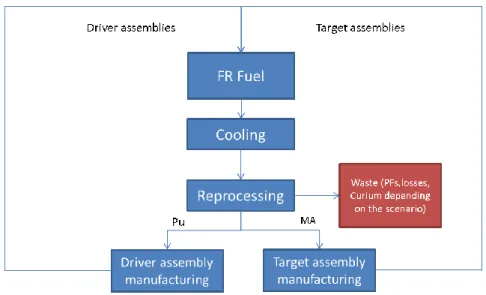
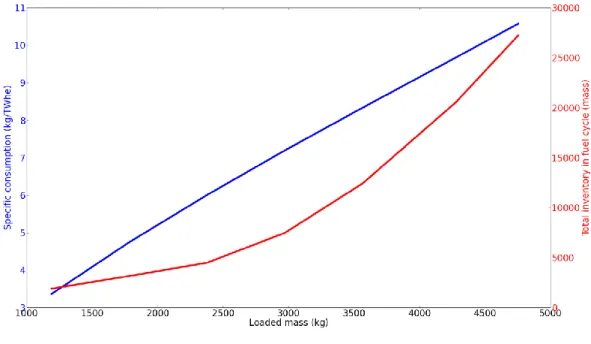

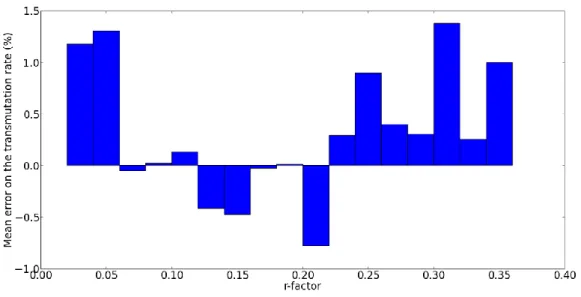
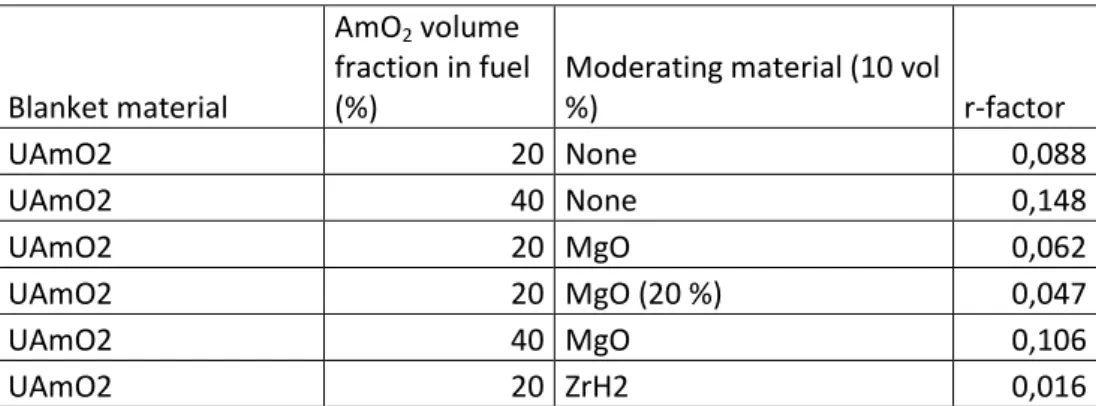
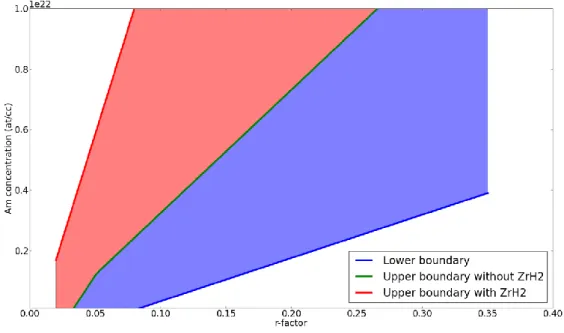
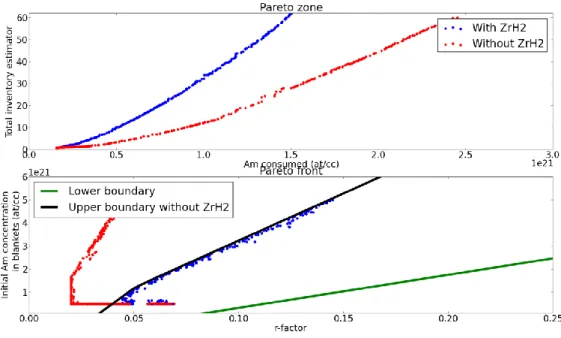
![Figure 6 : Comparison of the Pareto zone and front for a washing limit of 7784 (23352) n/s/g corresponding to (three times) the neutron source of a driver assembly of [14] after five years cooling and decay heat of 53 W/kg corresponding](https://thumb-eu.123doks.com/thumbv2/123doknet/13223289.394167/13.892.169.721.135.471/figure-comparison-pareto-washing-corresponding-neutron-assembly-corresponding.webp)
